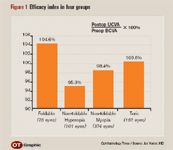Article
Iris-fixated phakic IOLs are effective, safe for hyperopia, myopia in analysis
Favorable results were realized when the efficacy, safety, and predictability outcomes were analyzed in 707 consecutive eyes with a phakic lens, toric phakic lens, or foldable phakic lens implanted.

Key Points

"There are certain disadvantages for cornea-based refractive procedures, and available papers indicate that when refractive error reaches the level of –8 to –9 D, optical correction needs to go inside the eye," said Dr. Venter, clinical director, Optimax Laser Clinics, London. "The iris-fixated IOL appears to be a good choice for treating high myopia and hyperopia with or without astigmatism. However, preoperative anterior segment imaging is critical to evaluating anterior chamber depth, iris vaulting, and anterior crystalline lens rise in order to identify appropriate candidates for this refractive procedure."
Patient demographics

After non-foldable phakic lens implantation, SE ranged from –2 to +1.25 D (mean, –0.27 D), 88% of eyes were corrected to within 1 D of emmetropia, and almost two-thirds were within 0.5 D. About 70% of eyes achieved an uncorrected visual acuity (UCVA) of 0.63 or better, and safety was excellent, with no eyes losing best-corrected visual acuity (BCVA); 36% of eyes gained 1 or more lines, and 7% gained 2 or more lines.
The demographic features of the myopic group with the non-foldable phakic IOL implanted were similar to those of the hyperopic group, and the predictability results were nearly identical as well. The myopic eyes had a preoperative SE ranging from –24 to –4.13 D (mean, –11.03 D) and achieved a mean postoperative SE ranging from –2.14 to +1.25 D (mean, –0.29 D).
Compared with the hyperopic group, a slightly higher proportion of the myopic eyes, 80%, achieved UCVA of 0.63 or better. A 1-line loss of BCVA occurred in 4% of eyes, but no eyes had a loss greater than 1 line. Forty-nine percent gained 1 or more lines, and 18% benefited with a 2-line or greater gain, Dr. Venter reported.
Newsletter
Don’t miss out—get Ophthalmology Times updates on the latest clinical advancements and expert interviews, straight to your inbox.




